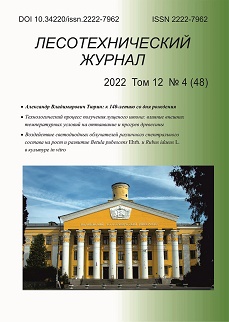Evaluation of the manifestation of Scots pine trees reaction to the weakening effect of Heterobasidion annosum (Fr.) Bref. is relevant from the perspective of the potential opportunities for further natural regeneration of the forest. The main reason for the decrease in the biological stability of the pine plantation was the development of the root sponge focus. Over the three-year period 2017-2019 the weighted average tree health category in the sample area increased from 2.21 to 2.52. The morphometric parameters of cones turned out to be more stable in the female generative sphere. Greater variability was noted for full-grain seed yield and the number of sterile apex scales. Relatively high preservation of seed ovules was found in the first and second vegetative periods of development within the boundaries of average values. For trees of different status categories during the whole period of observations it was 70.60-81.77 and 79.07-88.35% respectively, which indicated sufficient quality of pollination and marked compatibility of male and female genotypes against the background of reduced viability of mother trees. Embryo survival in the experiment reached 63.44-81.48%. The sensitivity of the generative sphere of Scots pine to the stress caused by the development of the disease has been proved. A significant decrease in the average length and diameter of mature cones and a relative increase in female reproduction rates were confirmed with the weakening and dying out of pine trees infected with root sponge. The possibility of identifying separate periods of preservation of ovules during gametophytic and embryonic cycles and the annual regularity of seed production allow us to recommend Scots pine for monitoring the state of the female generative sphere and assess the potential of the species to survive the action of aggressive stressors, such as Heterobasidion annosum (Fr.) Bref.
Scots pine, root sponge focus, tree condition categories, seeds, seed-bearing and embryo preservation.
1. Vy`soczkij A.A., Korchagin O.M. Kornevaya gubka v nasazhdeniyax sosny` oby`knovennoj (Pinus sylvestris L.). Pro-blemy` i puti resheniya. Izvestiya Sankt- Peterburgskoj lesotexnicheskoj akademii. 2018; 224: 176-192.(In Russ.). DOI: https://doi.org/10.21266/2079-4304.2018.224.176-192.
2. Piri T., Vainio E. J., Nuorteva H., Hantula J. High Seedling Mortality of Scots Pine Caused by Heterobasidion annosum s.s. Forests. 2021; 12(9): 1289. DOI: https://doi.org/10.3390/f12091289.
3. Aref`ev Yu. F., Senf V. A. Kornevaya gubka (Heterobasidion annosum (Fr.) Bref.) v sosnovy`x nasazhdeniyax srednerusskoj lesostepi i Floride - osobennosti kontrolya patogena. Lesotekhnicheskij zhurnal. 2017; 2: 6-11. (In Russ.).DOI: https://doi.org/10.12737/article_5967e851486a54.19241386.
4. Sazonov A. A., Zvyagincev V. B. Analiz struktury` lesozashhitny`x meropriyatij v ochagax sosnovoj kornevoj gubki. Trudy BGTU. 2019; 1(2): 126-131. (In Russ.). URL: https://elib.belstu.by/bitstream/123456789/30291/1/Sazonov_Analiz_struktury.pdf.
5. Ivanov V. P., Marchenko S. I., Glazun I. N., Nartov D. I. Ocenka vliyaniya morfometricheskix parametrov shishek na kachestvo semennogo materiala sosny obyknovennoj. Lesnoj zhurnal. 2018; 4: 19-30. (Izv. vy`ssh. ucheb. zavedenij). (In Russ.). DOI: https://doi.org/10.17238/issn0536-1036.2018.4.19.
6. Kuznetsova N. F., Klushevskaya Ye. S. Smena zhiznennogo sostoyaniya kak sposob vyzhivaniya Pinus sylvestris L. na tekhnogenno zagryaznennoy territorii. Printsipy ekologii. 2020; 2: 40-47. DOI: https://doi.org/10.15393/j1.art.2020.10322.
7. Kuzneczova N. F., Klushevskaya E. S., Amineva E. Yu. Vy`sokoproduktivny`e sosnovy`e lesa v usloviyax izmeneniya klimata. Lesnoj zhurnal. 2021; 6: 9-23. (Izv. vy`ssh. ucheb. zavedenij). (In Russ.). DOI: https://doi.org/10.37482/0536-1036-2021-6-9-23.
8. Karasev V. N., Karaseva M. A., Mukhortov D. I. Diagnostika fiziologicheskogo sostoyaniya khvoynykh derev'yev po bioelektricheskim i temperaturnym pokazatelyam. Lesovedeniye. 2020; 2: 162-174. DOI: https://doi.org/10.31857/S0024114820010088.
9. Kuznetsova N. F., Semenov M. A., Sautkina M. Yu. Pine Forests of East European Plain: Distribution Trends, Functions and Development Problems. Pinus: Growth, Distribution and Uses. New York, Nova Science Publishers, Inc. 2019: 1-47.
10. Chuprov A. V., Nakvasina Ye. N., Prozherina N. A. Izmenchivost' shishek sosnyobyknovennoy (Pinus sylvestris L.), proizrastayushchey v geograficheskikh kul'turakh Arkhangel'skoy oblasti. Lesnoy vestnik [Forestry Bulletin]. 2021; 25(3): 24-33. (In Russ.). DOI: https://doi.org/10.18698/2542-1468-2021-3-24-3.
11. Balekogu S., Calinskan S. Dirik H. Effects of geoclimatic factors on the variability in Pinus pinea cone, seed, and seedling traits in Turkey native habitats. Ecological Processes. 2020; 9: 55. DOI: https://doi.org/10.1186/s13717-020-00264-3.
12. Kuznetsova N. F., Klushevskaya Ye. S. Mekhanizmy vyzhivaniya Pinus sylvestris L. v zasukhu na tekhnogenno zagryaznen-noy territorii. Printsipy ekologii. 2022; 2: 68-77. (In Russ.). URL: http://ecopri/ru.
13. Kukunova T. A., Kisternyy G. A. Osobennosti zhenskoy reproduktsii v oslablennykh nasazhdeniyakh Uchebno-opytnogo leskhoza BGITU. Aktual'nyye voprosy tekhniki, nauki, tekhnologiy: Sb. nauch. tr. natsional'noy nauch. konf. (Bryansk, 05-09 fevralya 2019 g.). Bryan. gos. inzhener.-tekhnol. un-t. Bryansk. 2019:57-60. (In Russ.). URL: https://elibrary.ru/item.asp?id=37185942.
14. Kisternyj G. A. Zhenskaya reproduktivnaya sfera sosny obyknovennoj pri vozdejstvii oslablyayushhikh lesopatologicheskikh faktorov v nasazhdeniyakh Bryanskoj oblasti // Lesnoj zhurnal. 2016; 4: 89-99. (Izv. vyssh. ucheb. zavedenij). (In Russ.). DOI: https://doi.org/10.17238/issn0536-1036.2016.4.89.
15. Surso M. V. Mikrofenologiya zhenskogo reproduktivnogo cikla i struktura urozhaev semyan sosny obyknovennoj v severnoj tajge. Lesnoj zhurnal. 2015; 2: 50-60. (Izv. vyssh. ucheb. zavedenij). (In Russ.). DOI: https://doi.org/10.17238/issn2541-8416.2017.17.4.355.
16. Kukunova T. A., Kisternyy G. A. Zhenskaya reproduktivnaya sfera derev'yev sosny obyknovennoy razlichnykh kategoriy sostoyaniya. Sreda, okruzhayushchaya cheloveka: prirodnaya, tekhnogennaya, sotsial'naya: Mater. IX Mezhdunar. nauch.-prakt. konf. (Bryansk, 23-25 aprelya 2020 g.). Bryan. gos. inzhener.-tekhnol. un-t. Bryansk. 2020: 39-43. (In Russ.). URL: http://bgitu.ru/upload/iblock/304/Sbornik_2020_sreda.pdf.
17. Ob utverzhdenii Pravil sanitarnoj bezopasnosti v lesakh. Postanovlenie Pravitelstva RF ot 9 dekabrya 2020 g. N 2047. (In Russ.). URL: https://docs.cntd.ru/document/573053313#6540IN(accessed 14.02.2022).
18. Pitkänen T. P., Piri T., Lehtonen A., Peltoniemi M. Detecting structural changes induced by Heterobasidion root rot on Scots pines using terrestrial laser scanning. Forest Ecology and Management. 2021; 492: 10. DOI: https://doi.org/10.1016/j.foreco.2021.119239.
19. Pavlov I. N. (et al.). Mass Reproduction of Polygraphus proximus Blandford in Fir Forests of Siberia Infected with Root and Stem Pathogens: Monitoring, Patterns, and Biological Control (2020). Contemporary Problems of Ecology. 2020; 13(1): 71-84. DOI: https://doi.org/10.1134/S1995425520010060.
20. Marchiulynas A. (et al.). Resistance of Scots pine half-sib families to Heterobasidion annosum in progeny field trials. Silva Fennica. 2020; 54(4): 1-17. (In Russ.). DOI: https://doi.org/10.14214/sf.10276.












